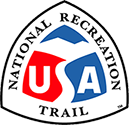




From Kofa National Wildlife Refuge
An area of rugged beauty, Palm Canyon may be the only place in Arizona where native palm trees, California Fan Palms, can be found.


Designated in 2007
• View more details for this trail
in the NRT Database
• Learn about the NRT Program.
The Palm Canyon Trail is a moderately easy, half-mile trail that winds up toward the base of the canyon. This trail leads to a small sign on a slightly elevated area near the middle of the canyon. By looking upward in the narrow, north trending side canyon, you will see the palms clearly. For a short time, at mid-day, the trees are well lighted for pictures. Otherwise, the trees are shaded. Beyond the trail, there is the prospect of hiking further up into the canyon. This hike is much steeper and without a defined trail, but allows for up-close examination of the magnificent palms!
Perhaps the only native palm trees in Arizona are tucked away in narrow, rugged canyons on the Kofa National Wildlife Refuge. People were aware of the small, scattered clusters of trees growing in Palm Canyon even before the creation of the refuge. The palm trees have become a major visitor attraction for the refuge.
To be specific, the trees are California fan palms, Washingtonia filifera. They are not date bearing palms. These unique plants are probably the descendants of palms growing in this region during the last periods of North American glaciation. Some botanists theorize that the trees gradually spread into these canyons and other protected niches as the climate warmed to desert conditions. Other researchers have suggested that the trees may have been spread from other palm groves by birds or coyotes carrying seeds in their digestive tracts.
Since Palm trees do not produce annual growth rings like shade trees, it's very difficult to say how old the trees might be. In Palm Canyon, the palm trees are able to survive in the narrow side canyons where direct sunshine is limited but some moisture is available. The survival of these trees is directly dependent on the micro-climate in this protected canyon.
As you follow the trail into the canyon, you will pass several species of plants unfamiliar to many visitors. The palo verde, a small tree with bright green branches and stems, rarely has leaves on it and grows in the washes in this area. The plant's branches and twigs have enough chlorophyll to produce all the food the tree requires. Ironwood, a grey-green tree with small leaves, is also present in the wash where the trail crosses. Its leafy stems are covered with thorns.
You may see a variety of wildlife as you walk along the trail. Keep watching the skyline on both sides of the canyon for bighorn sheep. These agile mammals may be seen in Palm Canyon, usually early in the morning, moving along ridge tops or staring down at you. Listen; coyotes occasionally cry out. If you hear their yelping, you will not forget it.
Birds are numerous most of the year in Palm Canyon. Watch for gnat catchers, canyon towhees, and thrashers flitting about in the underbrush. In the spring and summer, look for the jet black phainopepla hawking insects. White-throated swifts can be heard calling back and forth as they dart about over your head doing their acrobatics in the narrow canyon. If you are lucky you will hear the musical call of the canyon wren echoing off the canyon walls. High above, turkey vultures or golden eagles occasionally soar into view.
It is a very rugged climb up to the palm trees. If you decide to try it, plan on an extra 30-40 minutes to get up to the trees and back to the bottom of the canyon. There is no drinking water or sanitary facilities on the Kofa Refuge. Bring water with you and plan to take some on your walk if you are here in the summer. If you have pets, keep them on the trail and on a leash or consider tying them outside the car. Pets unfamiliar the desert often have problems with cactus spines.
Forming of the Canyon Palm Canyon is cut through a formation of rhyolite, a volcanic rock. Water, following cracks in the rhyolite, has eroded this canyon to its present shape. The side canyons, where the palms are located, are now being formed through the same process.
Camping is permitted on the refuge. Please consult the Regulations Leaflet for details. Overnight parking is permissible in the Palm Canyon parking area.
Finding Palm Canyon is relatively easy. Take U.S. Highway 95 approximately 63 miles north of Yuma or 18 miles south of Quartzsite, watch for the Palm Canyon sign, which indicates the junction with a dirt road. Follow the dirt road east for seven miles toward the large, block mountain. The road is passable in a passenger car, but the ride is rough.
Kofa National Wildlife Refuge 356 West First Street Yuma, Arizona 85364 (928) 783-7861 - http://southwest.fws.gov